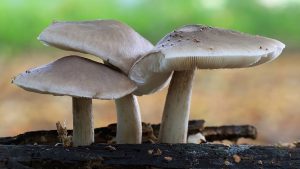#047: Mushroom Morphology: Truffles
Truffles are ascomycetes that form below-ground (hypogeous) fruiting bodies. These mushrooms look like small, lumpy potatoes on the outside. When cut open, truffles have a marbled appearance. Like the false truffles and sequestrate basidiomycetes, true truffles have evolved to retain moisture in arid climates or other harsh conditions. Truffles evolved from cup-shaped ascomycetes with a spore surface exposed to the air. To keep the spores moist, the cup became closed. Eventually, the interior surface became wrinkled and condensed, creating the marbled interior. There are a number of truffle species that exhibit various stages along this evolutionary path. Many of these truffles are hollow on the inside, as the gleba (interior, spore-producing tissue) has not fully become compacted. All truffles rely on animals – usually small mammals – to dig up the fruiting bodies and eat them. Truffles attract these animals by producing various scents. These scents are what give edible...







![#011: Characteristics of Kingdom Fungi [Archived]](https://www.fungusfactfriday.com/wp-content/themes/hueman/assets/front/img/thumb-small-empty.png)

